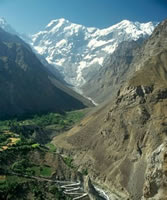Islamabad The Capital city
 Islamabad, by virtue of its lush green mountains, pollution fee environment, scenic beauty and modern civic amenities, has an irresistible attraction for people both at home and abroad.
Islamabad, by virtue of its lush green mountains, pollution fee environment, scenic beauty and modern civic amenities, has an irresistible attraction for people both at home and abroad.This pull has been further enhanced by the city's wide open roads, modern town planning, clean residential areas and good security.
Therefore, owning a home in Islamabad must have been dream of those who have visited this city once in their lifetime.
The name of the capital city of Pakistan means “the abode of Islam”. Islamabad is new, planned, spacious leafy and green. The wide roads, detached houses and gardens contrast somewhat with the old Pakistani city (twin city) of Rawalpindi. The city was envisaged by Field Marshal Ayub Khan on an entirely new site which he thought suitable. Lahore might well have been the new capital but for its proximity to the Indian border. Islamabad is expeditious, bordering the two provinces of Punjab and north-west Frontier, near the hills with a healthy unpolluted climate.
Islamabad is the capital of Pakistan; it is located in the Pothohar Plateau in the northwest of country. It is referred as Islamabad Capital Territory, though the area has historically been a part of the Punjab region and the North-West Frontier Province (the Margalla pass has been a gateway to the North-West Frontier Province, and the Pothohar Plateau been a part of the Punjab. It is located at 33°40′N 73°10′E.
Geography and climate Islamabad is situated at the edge of the Pothohar plateau, south of the Margalla hills. The Islamabad and the Rawalpindi stand side by side. The area's micro-climate is regulated by three man-made lakes: Rawal, Simli and Khanpur. The city has hot summers with monsoon rains occurring during July and August. Even on the few winter days when pre-dawn temperatures fall below freezing, the afternoons are usually sunny and mild: in the coldest month, January, theaverage daily maximum temperature is 16°C (61°F).Government and administration:
The Capital Development Authority (CDA) established in 1960 to undertake municipal functions through legislative amendments in 1966.
The old deputy commissioner system is still in practice in Islamabad.The Capital Territory has population of 901137 and is divided into two segments: Islamabad Urban area, including institutional and industrial area, and Islamabad rural area. The rural area of Islamabad encompasses 133 villages and administratively consists of 12 Union Councils. Administratively Islamabad is divided into 3 subdivisions namely City, Sadar and Rural. Islamabad sectorsIslamabad is divided into five sectors from sector D to I with each sector covering an area of approximately 2km x 2km.DemographicsPunjabis account for 65% of the population followed by the Muhajirs at 14% and then the Pashtun which account for somewhere between 10-20%. Sites of interestIslamabad though a new city as compared to the other civic centers of Pakistan, but it has enough in store for those with passion for beauty and serenity. Some of the worth seeing places of capital are as follows:· Shah Faisal Mosque· Margalla hills· Daman-e-Koh· Taxila and the world's oldest University, Takshashila · Shaker Parrian · Golra Sharif· Lotus Lake · Pakistan Museum of Natural History · Islamabad Museum · Islamabad Zoo · Lok Virsa Museum · Supreme Court of Pakistan · National Parliament of Pakistan · Japanese Park · Chinatown · Chattar Bagh · Fatima Jinnah Park · Rawal Dam · Play Land.
Education Islamabad has some of the best and modern educational institutions in Pakistan. The major educational centers are as follows:·
Bahria University (Sector E-8) ·
Quaid-i-Azam University (Sector G-4) ·
International Islamic University (Sector H-10) ·
Allama Iqbal Open University (Sector H-8) ·
Shifa International Hospitals Ltd (Sector H-8) ·
National University of Modern Languages (Sector H-9) ·
COMSATS Institute of Information Technology (Sector H-9) ·
Federal Urdu University of Arts, Science & Technology (Sector G-7) ·
National University of Computer & Emerging Sciences(FAST-NUCES) (in Sector H-11) · Air University (Sector E-9) ·
Al-Huda University (Sector H-11) ·
SZABIST (Sector F-8) ·
Muhammad Ali Jinnah University.



Comments
Post a Comment